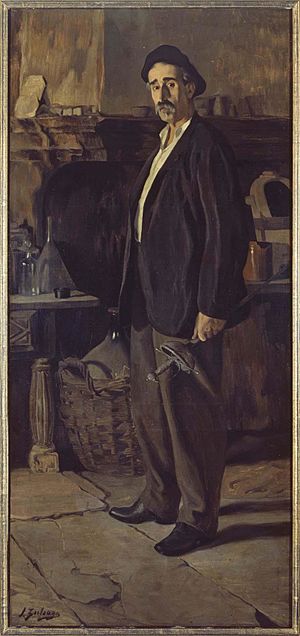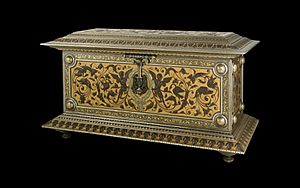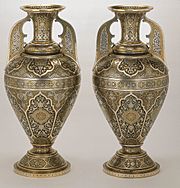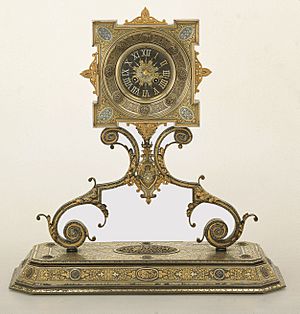Plácido Zuloaga facts for kids
Quick facts for kids
Plácido Zuloaga
|
|
|---|---|

Plácido painted by his son, Ignacio Zuloaga
|
|
| Born | 5 October 1834 |
| Died | 1 July 1910 (aged 75) |
| Nationality | Spanish |
| Known for | damascening |
| Spouse(s) | Lucía Zamora y Zabaleta, Francisca Gil y Lete |
Plácido Zuloaga (born October 5, 1834 – died July 1, 1910) was a talented Spanish artist. He was a sculptor and worked with metals. He became famous for improving a special art technique called damascening. This is where you press gold, silver, or other metals into an iron surface. It creates beautiful, detailed designs.
Plácido came from a family of skilled metalworkers from the Basque region of Spain. His father, Eusebio Zuloaga, was a pioneer in damascening. His half-brother, Daniel Zuloaga, was an artist, and his son, Ignacio Zuloaga, became a famous painter. Plácido took over his father's factory, which used to make weapons. He changed it to create amazing art pieces instead. He showed these artworks at big international fairs and won many awards.
Some of his most famous works include the altar for the Sanctuary of St. Ignatius at Loyola. He also made the Fonthill Casket, which is an iron chest with very detailed designs. Another important piece was a large stone coffin, called a sarcophagus, for the Spanish Prime Minister, Juan Prim. For twenty years, Zuloaga created art for an English collector named Alfred Morrison. Many of these pieces are now part of the private collection of Nasser D. Khalili. Zuloaga taught many other artists in his workshop. Because of him, the town of Eibar continued to be a center for damascening even after he passed away.
Contents
Early Life and Training
Plácido Zuloaga was born on October 5, 1834, in Madrid, Spain. His parents were Antonia and Eusebio Zuloaga. His brother, Daniel Zuloaga, became a painter and ceramic artist. Plácido's father was in charge of the Spanish Royal Armoury. He was also one of the first to use the damascening technique.
The Zuloaga family had been making weapons in their workshop in Eibar since 1596. Plácido started learning in his father's workshop when he was very young. At fourteen, he traveled to Paris, France. There, he learned from a famous armor maker named Lepage. Later, in Dresden, Germany, he studied with sculptors Antoine-Louis Barye and Jean-Baptiste Carpeaux.
A Career in Art
In 1867, Plácido's father let him take over the family factory in Eibar. It is believed that Plácido had already been doing his father's art orders for about ten years. The workshop stopped getting orders from the royal family in 1868. This happened when Queen Isabella II was sent away from Spain.
Plácido then got in touch with Alfred Morrison, an English art collector. Morrison was very rich from his family's textile business. Plácido had met him at an art show in London in 1862. For the next twenty years, Zuloaga and his workshop worked almost only for Morrison. They changed the factory from making weapons to creating beautiful damascened art pieces.
The Art of Damascening
Damascening is a special process. First, you make small dents in an iron surface. Then, you press thin gold wires into these dents. The surface is then heated, which makes the gold wires join together firmly. Today, people use acid to make the dents. But the Zuloaga family used hand tools for this step.
Plácido Zuloaga made his father's technique even better. He found new ways to make the iron surface rough. Then, he added very fine gold and silver wires. He hammered these wires until they were firmly joined. Other hand tools were used to press detailed designs onto the metal. Plácido worked at a time when gold was easy to find. This meant his artworks used much more gold than later damascene pieces. His objects were so delicate that they would be damaged if used for everyday purposes. Plácido wanted to create beauty, not just useful items. To help his workshop, he collected sculptures, paintings, and plaster copies of armor. From 1860 to 1890, Zuloaga taught more than 200 artists how to do damascening.
Famous Works
Zuloaga was skilled in all the metalworking techniques of his time. These included forging (shaping metal with heat), relief chiseling (carving designs that stand out), engraving (cutting designs into metal), drawing, and enameling (adding glass-like coatings). To finish his biggest projects on time, he led a team of skilled artisans. Each person helped with his designs, and each object was made by eight to twelve people.
More than a hundred pieces of Spanish damascened metalwork are in the collection of Nasser D. Khalili. Twenty-two of these pieces are signed by Zuloaga. One famous piece is the Fonthill Casket. It is a 201-centimetre-wide (79 in) iron chest with gold and silver damascening. It also has white enamel designs in black. The casket is beautifully decorated both inside and out, showing it was made purely for art. Alfred Morrison ordered this piece, and it got its name from Fonthill manor, his family home. Zuloaga and his team spent two years making the casket. In 1879, The Magazine of Art called it "a triumph of skilled workmanship."
Morrison also ordered a pair of tall, urn-shaped vases. They were 108 centimetres (43 in) high and made in 1878. Their style copied the medieval Alhambra vases. These urns were covered in detailed Hispano-Arabic designs. They were shown in Paris before being sent to Morrison.
A writing desk from 1884–1885 has 44 drawers in a wooden case. Each drawer has enameled flower patterns and a damascened metal handle. Zuloaga did not work with wood himself. He hired others to prepare the wood and veneer for the desk. An iron shrine from 1880, 47.3-centimetre-high (18.6 in), looks like Gothic architecture. But its detailed damascened decoration reminds us more of Art Nouveau. It holds a silver statue of the Virgin and Child in a Gothic style. Other objects signed by Zuloaga include a revolver, snuff boxes, and various other containers.
Around 1872, Zuloaga's workshop was asked to make a large sarcophagus for General Juan Prim. The work started in Eibar. But because of a civil war in 1873, Zuloaga moved his workshop to Saint-Jean-de-Luz in France. The sarcophagus was finished there. Prim's tomb is now in the cemetery at Reus. Around 1900, the Society of Jesus asked Zuloaga to build an altar for the Sanctuary of St. Ignatius at Loyola. This was his last big project. It was finished and put in place in 1909, while he was still alive. In 1981, Pedro Celaya called it "one of the greatest works... that has been produced in Eibar."
-
Iron shrine with virgin and child, 1880
Recognition and Legacy
Zuloaga passed away in Madrid on July 1, 1910, at the age of 76. He was buried in Canillejas. Several of his students became famous artists themselves. Eibar remained a center for Spanish damascene art until the Spanish Civil War.
During his life, Zuloaga received many honors. He was an Officer of the French Legion of Honor. He was also a Knight Commander of the Order of Isabel the Catholic. He won many gold and silver medals at national and international art shows.
People's opinions of Zuloaga's art have changed over time. In 1872, an art expert from the South Kensington Museum (now the Victoria and Albert Museum) said that a vase decorated by Zuloaga "will be regarded as one of the greatest Art productions of the century." An article in The Magazine of Art in 1879 praised his works. It said they showed great patience and effort. This effort was like artists from an earlier time who focused only on their craft. They did not worry about how much time, trouble, or money it cost.
In the early 1900s, some art critics did not like the Zuloaga family's works as much. But in the last few decades of the 20th century, new interest and appreciation for their art grew. Nasser Khalili, a collector, says that "Spain has always led the West in its beauty and quality of its damascene production." He describes Zuloaga as "the supreme damascener of [his] family."
Exhibitions
Zuloaga showed his artworks at several important events. He exhibited at the 1855 Paris International Exposition. There, he won a Medal of Honor. He also showed his art at the Madrid and Brussels International exhibitions in 1856. Then, he was at the Great London Exposition in 1862.
More recently, his works from the Khalili Collections have been in many exhibitions. "Plácido Zuloaga: Spanish Treasures from The Khalili Collection" was at the Victoria and Albert Museum in London. This show ran from May 1997 to January 1998. "El Arte y Tradición de los Zuloaga: Damasquinado Español de la Colección Khalili" toured Spain in 2000 and 2001. It was shown at the Museo de Bellas Artes in Bilbao, the Alhambra Palace in Granada, and the Real Fundacion de Toledo. In 2003, "Plácido Zuloaga: Meisterwerke in gold, silber und eisen damaszener–schmiedekunst aus der Khalili-Sammlung" was shown in Germany. "Metal Magic: Spanish Treasures from the Khalili Collection" was exhibited in Malta from November 2011 to April 2012.
Personal Life
Plácido Zuloaga had ten children with his first wife, Lucía Zamora y Zabaleta. Five of them lived to be adults. One of his sons was Ignacio Zuloaga, who became a famous painter. After Lucía passed away in 1900, Plácido married Francisca Gil y Lete.
See also
 In Spanish: Plácido Zuloaga para niños
In Spanish: Plácido Zuloaga para niños







